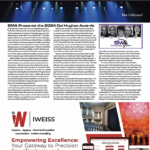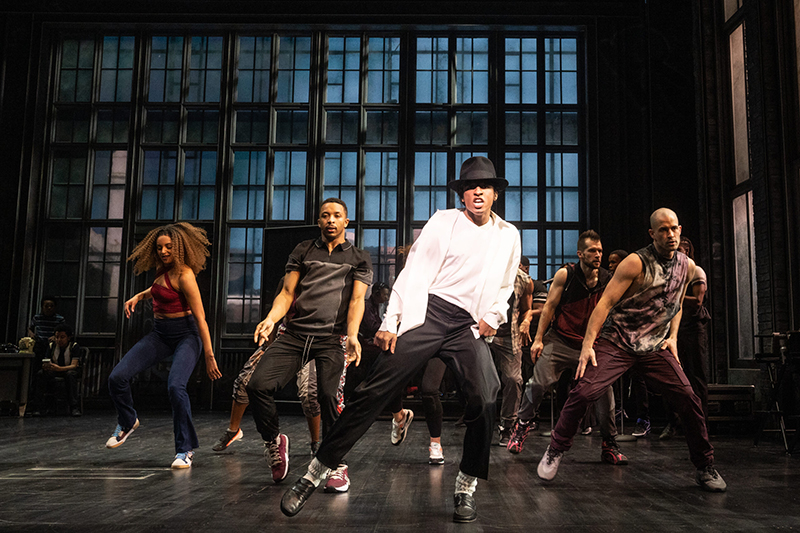
As one of the most anticipated new productions of the Broadway season, MJ: The Musical, playing at the Neil Simon Theatre, came with an innate pressure on the design team. Scenic Designer Derek McLane acknowledges that creating the design was intimidating because of the pressure to capture Jackson’s showmanship, ambition and imagination. “I was aware I had a standard to live up to and had to deliver some big moments that were worthy of Michael and his fans.” The musical, centered around the making of Michael Jackson’s 1992 Dangerous World Tour, was created by Director/Choreographer Christopher Wheeldon and written by Lynn Nottage. Joining McLane on the creative team were Lighting Designer Natasha Katz and Projection Designer Peter Nigrini.
Rehearsal Room
Scenically speaking, this is a big show and the scenic pieces are central to the plot. McLane’s design firmly plants the show in the tour’s rehearsal room, which takes up the whole stage. On the sides of the stage are 30 feet tall and 4 feet wide window walls which pivot to open and close, allowing actors and set pieces to move on and offstage. An upstage wall of windows that is 20 feet high and 27 feet wide, which splits in the center to move on and off stage on an automated track, completes the industrial warehouse feel. McLane refers to these walls as the “engine” of the set. As the plot unfolds, the audience is transported to other locations through Jackson’s flashbacks and then returns to the rehearsal room. PRG, providing the lighting, scenic and automation for the production, used PRG’s proprietary Stage Command System®, a cue-based motion control system, to ensure that the walls move fluidly into place, completely synchronized. No small feat, considering the size and weight of the walls.
“While the rehearsal room looks like a realistic brick and metal industrial space, in fact it has to do all this magic. PRG did such a good job of building all this magic in there so what happens, happens seamlessly. The automation is really good and reliable, and when teching a show, PRG’s automation provides the ability to cue it in a way that is quick and subtle, and with just the right speeds and acceleration/deceleration which is very important,” said McLane.
As the scenic shop, PRG undertook a huge amount of research to find the right material, thickness, and treatment for the window walls. “We wanted to use Lexan for less distortion but it didn’t work well as a projection surface, so we ended up using real glass,” explains Mark Peterson, PRG general manager, sales and business development. “We went through a painstaking but very successful process of collaborating with the different departments — scenic, lighting, projection — to determine what would work best. We wanted the windows to look clear, like real windows, but they had to be reflective for projection and transmissive for lighting. Once we landed on the material, the next step was determining the level of transparency that would reduce glare from surrounding lights but had enough texture for rear projection. Implementing this window treatment was a challenge as well since it had to be applied by hand and be uniform across all the windowpanes.”
For Lighting Designer Natasha Katz, the rehearsal room walls provided a large canvas. “There are as many lights off stage as there are on stage to light those windows. There are two moving lights behind each of the 18 panes of window and a projection screen sits behind the upstage window wall. The frost treatment allows the windows upstage and on the sides of stage to take color really well,” said Katz.
The room’s lighting is very naturalistic—lights shining through the windows change hues to indicate the time of day, as the sun rises and sets. Throughout the musical, Katz recreated the feel of the time period and location. “What makes the show so special for me is that it is reality-based but also memory-based. It is our version of what we think his memory might be,” said Katz. “As we go into the memories, it becomes a very saturated, colored world. The windows, which are extremely present, become very colorful and the LED wall upstage does a similar thing that the side windows are doing.”
With over 400 fixtures, MJ: The Musical is one of the larger lighting rigs on Broadway. PRG provided the lighting package, including a Multiverse Wireless DMX System from City Theatrical, one of the first for a Broadway musical. ““PRG did an amazing job,” Katz notes. “They understand they are in the service business and that is absolutely what they do.”
Another show challenge for Katz was the amount of lighting that was embedded in the scenery. “There are a lot of lights built into the scenery so Derek and I collaborated on that, which was exciting,” Katz continued. “Fred Gallo [president, PRG Scenic] engineered much of how we were able to hide lights in the set, which was an extremely difficult job. Also, the side walls have lights in them—there is City Theatrical’s QolorFLEX NuNeon, and we also have Calesco lights that we had to make room for. It was an extraordinary task.”
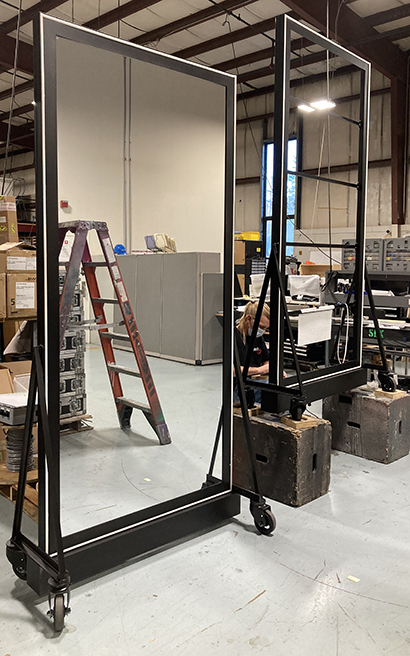
Mirror Motif
The show also has a significant mirror motif. Actors roll in large 3 ½ feet wide by 8 feet tall mirror panels, seven in all, which can be used in varying configurations. The reverse side of the panels provides scenic treatments for locations like Michael’s childhood bedroom or the Motown recording studio. The panels, which are quite heavy, are moved often (and quickly). Again the PRG shop had to ensure they were up to the task and could withstand heavy use. Like the side window walls, QolorFLEX NuNeon is installed in many of the set pieces, including four of the mirror panels, used in key moments like the “Man in the Mirror” number. “Used mostly in musical numbers, the NuNeon helps to change a space from realism into something more heightened—into ‘show business’ moments – with just a flick of a switch,” McLane said. “The great advantage is that we can transform a piece of scenery, without having to move anything. It works really well and is embedded in a lot of the architecture of the set.”
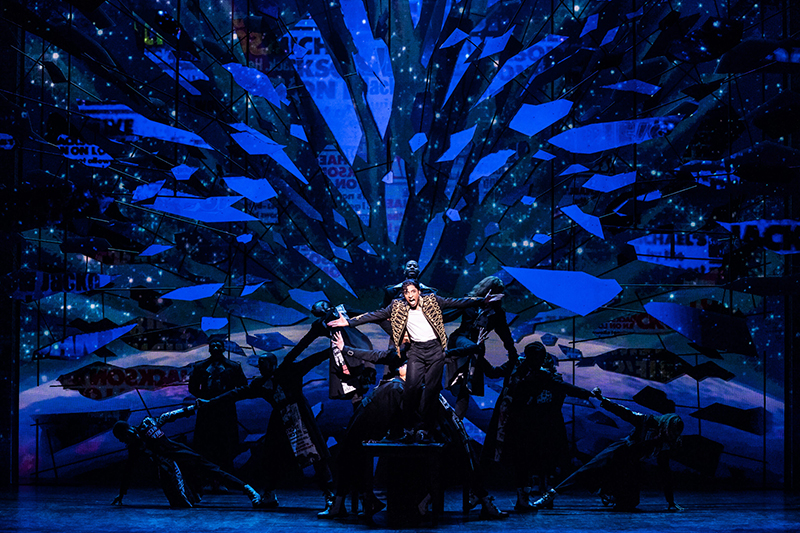
For the musical number “They Don’t Care About Us,” McLane envisioned shattered mirror pieces flying through the air to capture the stress that Michael is feeling in the scene. The shop created two intricate and delicate metal frames to hold 160 mirror shards made of Lexan. The frames, which are on two separate automated traveler tracks, had to be incredibly minimal so that it would appear that the shards were floating.
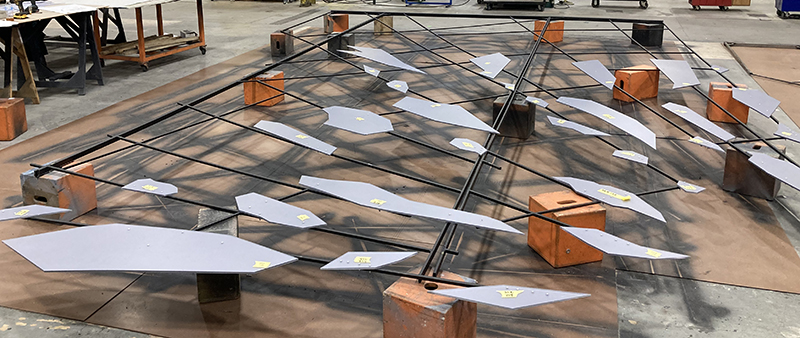
A Successful Team Effort
“I am really happy with the look of the show,” said Katz. “All the designers and the director worked hand in glove. Derek’s set is extraordinary. You feel so solidly in the rehearsal room and then suddenly you are taken back 30 years. The scenery and Peter’s projection go hand in hand, the music and lights too. The lights are tied to what is happening musically. If there is a key change, the lights change. There is a light cued with every beat. Everything worked absolutely perfectly.”
McLane echoed Katz’s sentiments about the collaborative nature of the team. “I had such a good time working on this. Everyone — managers, carpenters, painters — was so devoted to making this great. It was a long process because we started on it before the pandemic but it was a great experience.”
A longer version of this PRG sponsored story appears at https://bit.ly/3hOdCww
